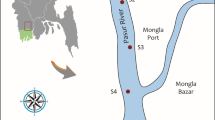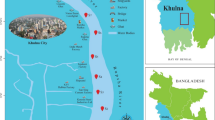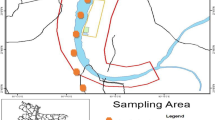Abstract
In this study, accumulation of the top six most toxic trace metals (Arsenic (As), Cadmium (Cd), Chromium (Cr), Mercury (Hg), Nickel (Ni) and Lead (Pb)) were assessed in six indigenous fish species (Barilius barila, Salmostoma acinaces, Gudusia chapra, Labeo bata, Corica soborna, and Sperata aor) collected from the Old Brahmaputra River in Bangladesh. Human health risk associated with these fish consumption was also evaluated. Metals were analyzed in whole body of fish by an atomic absorption spectrometer (AAS). Mean concentrations of metals (μg/g, wet weight) were in the range of As (< 0.02–0.278), Cd (< 0.002–0.005), Cr (0.239–0.761), Hg (0.008–0.057), Ni (< 0.02–0.044), and Pb (< 0.01–0.038). The metal contents varied significantly among the fishes regarding their feeding habits and living habitats. Concentrations of As, Cr, Hg, and Pb were significantly higher in omnivorous species, whereas the benthopelagic species showed significantly higher accumulation of As (p < 0.05). The target hazard quotient (THQ) for noncarcinogenic risk and target cancer risk (TR) for carcinogenic risk were calculated to estimate the probabilities of experiencing these adverse health effects for the fish consumers. Metal-specific THQ values were all below 1 indicating no potential human health risk. Nonetheless, the hazard index (HI) values to estimate the effects from exposure to all metals collectively elucidated chronic noncarcinogenic health risk particularly from G. chapra consumption. The TR values revealed that there was carcinogenic risk from exposure to As through consumption of the fish. This study finally suggests a systematic and continuous monitoring of trace metal contamination in fishes from the river to ensure the fitness of this food item regarding the safety for human health.

Similar content being viewed by others
References
Manahan SE (2000) Environmental chemistry, seventh edn. Lewis Publishers, CRC Press LLC, Boca Raton, p 898
Yu T, Zhang Y, Hu XN, Meng W (2012) Distribution and bioaccumulation of heavy metals in aquatic organisms of different trophic levels and potential health risk assessment from Taihu Lake, China. Ecotoxicol Environ Saf 81:55–64
Ahmed MK, Shaheen N, Islam MS, Habibullah-Al-Mamun M, Islam S, Mohiduzzaman M, Bhattacharjee L (2015) Dietary intake of trace elements from highly consumed cultured fish (Labeo rohita, Pangasius pangasius and Oreochromis mossambicus) and human health risk implications in Bangladesh. Chemosphere 128:284–292
Ouattara AA, Yao KM, Soro MP, Diaco T, Trokourey A (2018) Arsenic and trace metals in three West African rivers: concentrations, partitioning, and distribution in particle-size fractions. Arch Environ Contam Toxicol 75:449–463
Islam MS, Ahmed MK, Raknuzzaman M, Habibullah-Al-Mamun M, Masunaga S (2015) Chemical speciation of trace metals in sediment and their bioaccumulation in fish of three urban rivers around Dhaka City, Bangladesh. Arch Environ Contam Toxicol 68:92–106
Ahmed MK, Baki MA, Kundu GK, Islam MS, Islam MM, Hossain MM (2016) Human health risks from heavy metals in fish of Buriganga river, Bangladesh. Springerplus 5(1):1697
Celik A, Demirbas A (2005) Removal of heavy metal ions from aqueous solutions via adsorption onto modified lignin from pulping wastes. Energy Sources 27:1167–1177
Ahmed MK, Habibullah-Al-Mamun M, Hossain MA, Arif M, Parvin E, Akter MS, Khan MS, Islam MM (2011) Assessing the genotoxic potentials of arsenic in tilapia (Oreochromis mossambicus) using alkaline comet assay and micronucleus test. Chemosphere 84:143–149
Ahmed MK, Kundu GK, Al-Mamun MH, Sarkar SK, Akter MS, Khan MS (2013) Chromium (VI) induced acute toxicity and genotoxicity in freshwater stinging catfish, Heteropneustes fossilis. Ecotoxicol Environ Saf 92:64–70
Ahmed MK, Parvin E, Islam MM, Akter MS, Khan MS, Habibullah-Al-Mamun M (2014) Lead and cadmium induced histopathological changes in gill, kidney and liver tissues of freshwater climbing perch Anabas testudineus (Bloch, 1792). Chem Ecol 30:532–540
Batool M, Abdullah S, Javed M (2014) Behavioral intoxication of Channa marulius and Wallago attu during acute exposure of cadmium and copper. Pak J Life Soc Sci 12:7–15
AnvariFar H, Amirkolaie AK, Jalali AM, Miandare HK, Sayed AH, Üçüncü Sİ, Ouraji H, Ceci M, Romano N (2018) Environmental pollution and toxic substances: cellular apoptosis as a key parameter in a sensible model like fish. Aquat Toxicol 204:144–159
Baruthio F (1992) Toxic effects of chromium and its compounds. Biol Trace Elem Res 32(1–3):145–153
Tchounwou PB, Patlolla AK, Centeno JA (2003) Carcinogenic and systemic health effects associated with arsenic exposure-a critical review. Toxicol Pathol 31:575–588
Kapaj S, Peterson H, Liber K, Bhattacharya P (2006) Human health effects from chronic arsenic poisoning–a review. J Environ Sci Health A Tox Hazard Subst Environ Eng 42:2399–2428
Telisman S, Colak B, Pizent A, Jurasovic J, Cvitkovic P (2007) Reproductive toxicity of low-level lead exposure in men. Environ Res 105:256–266
Bernard A (2008) Cadmium & its adverse effects on human health. Indian J Med Res 128(4):557–564
Forti E, Salovaara S, Cetin Y, Bulgheroni A, Tessadri R, Jennings P, Pfaller W, Prieto P (2011) In vitro evaluation of the toxicity induced by nickel soluble and particulate forms in human airway epithelial cells. Toxicol in Vitro 25:454–461
Rice KM, Walker EM, Wu M, Gillette C, Blough ER (2014) Environmental mercury and its toxic effects. J Prev Med Public Health 47(2):74–83
Hossain A, Nakamichi S, Habibullah-Al-Mamun M, Tani K, Masunaga S, Matsuda H (2018) Occurrence and ecological risk of pharmaceuticals in river surface water of Bangladesh. Environ Res 165:258–266
Thilsted SH, Roos N, Hassan N (1997) The role of small indigenous fish species in food and nutrition security in Bangladesh. NAGA 20(3/4):82–84
BBS (2019) Report on the household income and expenditure survey 2016. Bangladesh Bureau of Statistics, Statistics division, Ministry of Planning, Bangladesh
Raknuzzaman M, Ahmed MK, Islam MS, Habibullah-Al-Mamun M, Tokumura M, Sekine M, Masunaga S (2016) Trace metal contamination in commercial fish and crustaceans collected from coastal area of Bangladesh and health risk assessment. Environ Sci Pollut Res 23(17):17298–17310
Bhuyan M, Abu Bakar M, Rashed-Un-Nabi M, Senapathi V, Chung SY, Islam MS (2019) Monitoring and assessment of heavy metal contamination in surface water and sediment of the Old Brahmaputra River, Bangladesh. Appl Water Sci 9:125
Zakir HM, Eti MSA, Quadir QF, Mallick S (2019) Health risk assessment of heavy metal intake of common fishes available in the Brahmaputra river of Bangladesh. Arch Curr Res Int 19(2):1–15
Sarah R, Tabassum B, Idrees N, Hashem A, Abd_Allah EF (2019) Bioaccumulation of heavy metals in Channa punctatus (Bloch) in river Ramganga (U.P.), India. Saudi J Biol Sci 26:979–984
Kindie M, Andargie M, Hilluf W, Amare M (2020) Assessment on level of selected heavy metals in Nile tilapia and Barbus fish species and water samples from the southern parts of Lake Tana, Ethiopia. Sci Afr 9:e00519
Shaheen N, Ahmed MK, Islam MS, Habibullah-Al-Mamun M, Tukun AB, Islam S, Rahim ATMA (2016) Health risk assessment of trace elements via dietary intake of ‘non-piscine protein source’ foodstuffs (meat, milk and egg) in Bangladesh. Environ Sci Pollut Res 23:7794–7806
Storelli A, Barone G, Dambrosio A, Garofalo R, Busco A, Storelli MM (2020) Occurrence of trace metals in fish from South Italy: assessment risk to consumer’s health. J Food Compos Anal 90:103487
US EPA (1989) Risk assessment guidance for superfund, Volume I: Human Health Evaluation Manual (Part A), Interim Final. The United States Environmental Protection Agency 540/1–89/002, Washington DC, USA
US EPA (1991) Technical support document for water quality-based toxics control. The United States Environmental Protection Agency, EPA/505/2–90-001, Washington DC
US EPA (2000) Risk assessment and fish consumption limits. III Edition. The United States Environmental Protection Agency, EPA 823-B-00-008. USA, Office of Water, Washington DC
US EPA (2020) Regional screening level (RSL) Summary Table (TR=1E-06, HQ=0.1). The United States Environmental Protection Agency, Washington, DC. Retrieved October 13, 2020 from: https://semspub.epa.gov/src/document/HQ/200057.pdf. Accessed 13 Oct 2020
Saha N, Zaman MR (2013) Evaluation of possible health risks of heavy metals by consumption of foodstuffs available in the central market of Rajshahi City, Bangladesh. Environ Monit Assess 185:3867–3878
Varol M, Kaya GK, Sünbül MR (2019) Evaluation of health risks from exposure to arsenic and heavy metals through consumption of ten fish species. Environ Sci Pollut Res 26:33311–33320
US EPA (2001) Risk assessment guidance for superfund, Volume I: Human Health Evaluation Manual (Part E, Supplemental Guidance for Dermal Risk Assessment), The United States Environmental Protection Agency, EPA/540/R/99/005. USA Office of Emerage and Remedial Response, Washington DC
GEMS/Food-Euro (1995) Reliable evaluation of low-level contamination of food, report on a workshop in the frame of GEMS/Food-Euro, Document EUR/ICP/EHAZ.94.12/WS04, Kulmbach, Federal Republic of Germany
ANZFA (2011) Contaminants and natural toxicants (F2011C00542), Australian and New Zealand food standards code, standard 1.4.1-. https://www.comlaw.gov.au/Details/F2011C00542. Accessed 02.01.19
EC (2006) Commission Regulation (EC) No 1881/2006 of the European parliament and the council of 19 December 2006 setting maximum levels for certain contaminants in foodstuffs. Off J Eur Communities L364/18. http://eur-lex.europa.eu/legal-content/EN/TXT/PDF/?uri=CELEX:32006R1881&from=EN. Accessed 24 March 2020
JECFA (2003) Summary and conclusions of the 61st Meeting of the Joint FAO/WHO Expert Committee on Food Additives
WHO (1989) Heavy metals-environmental aspects. Environmental health criteria no. 85, World Health Organization, Geneva, Switzerland. http://www.Who.Int/ipcs/publications/en. Accessed on 14.03.19
Liu H, Liu G, Wang S, Zhou C, Yuan Z, Da C (2018) Distribution of heavy metals, stable isotope ratios (δ13C and δ15N) and risk assessment of fish from the Yellow River estuary, China. Chemosphere 208:731–739
Siddiqui E, Verma K, Pandey U, Pandey J (2019) Metal contamination in seven tributaries of the Ganga river and assessment of human health risk from fish consumption. Arch Environ Contam Toxicol 77(2):263–278
Yousafzai AM, Chivers DP, Khan AR, Ahmad I, Siraj M (2010) Comparison of heavy metals burden in two freshwater fishes Wallago attu and Labeo dyocheilus with regard to their feeding habits in natural ecosystem. Pak J Zool 42:537–544
Jia Y, Wang L, Cao J, Li S, Yang Z (2018) Trace elements in four freshwater fish from a mine-impacted river: spatial distribution, species-specific accumulation, and risk assessment. Environ Sci Pollut Res Int 25(9):8861–8870
Kalyoncu L, Kalyoncu H, Arslan G (2012) Determination of heavy metals and metals levels in five fish species from Işıklı Dam Lake and Karacaören Dam Lake (Turkey). Environ Monit Assess 184:2231–2235
Borrell A, Tornero V, Bhattacharjee D, Aguilar A (2016) Trace element accumulation and trophic relationships in aquatic organisms of the Sundarbans mangrove ecosystem (Bangladesh). Sci Total Environ 545:414–423
Alamdar A, Eqani SAMAS, Hanif N, Ali SM, Fasola M, Bokhari H, Katsoyiannis IA, Shen H (2017) Human exposure to trace metals and arsenic via consumption of fish from river Chenab, Pakistan and associated health risks. Chemosphere 168:1004–1012
Xia W, Chen L, Deng X, Liang G, Giesy JP, Rao Q, Wen Z, Wu Y, Chen J, Xie P (2019) Spatial and interspecies differences in concentrations of eight trace elements in wild freshwater fishes at different trophic levels from middle and eastern China. Sci Total Environ 672:883–892
Oost R, Beyer J, Vermeulen NP (2003) Fish bioaccumulation and biomarkers in environmental risk assessment: a review. Environ Toxicol Pharmacol 13:57–149
Weber P, Behr ER, Knorr CDL, Vendruscolo DS, Flores EM, Dressler VL, Baldisserotto B (2013) Metals in the water, sediment, and tissues of two fish species from different trophic levels in a subtropical Brazilian river. Microchem J 106:61–66
Yi YJ, Yang ZF, Zhang SH (2011) Ecological risk assessment of heavy metals in sediment and human health risk assessment of heavy metals in fishes in the middle and lower reaches of the Yangtze River basin. Environ Pollut 159:2575–2585
Al-Yousuf MH, El-Shahawi MS, Al-Ghais SM (2000) Trace metals in liver, skin and muscle of Lethrinus lentjan fish species in relation to body length and sex. Sci Total Environ 256(2):87–94
Cai SW, Ni ZH, Li YF, Shen ZW, Xiong ZT, Zhang Y, Zhou YT (2012) Metals in the tissues of two fish species from the rare and endemic fish nature reserve in the upper reaches of the Yangtze River, China. Bull Environ Contam Toxicol 88(6):922–927
Jiang H, Qin D, Chen Z, Tang S, Bai S, Mou Z (2016) Heavy metal levels in fish from Heilongjiang river and potential health risk assessment. Bull Environ Contam Toxicol 97(4):536–542
Waheed S, Kamal A, Malik RN (2014) Human health risk from organ-specific accumulation of toxic metals and response of antioxidants in edible fish species from Chenab River, Pakistan. Environ Sci Pollut Res 21:4409–4417
Zhao S, Feng C, Quan W, Chen X, Niu J, Shen Z (2012) Role of living environments in the accumulation characteristics of heavy metals in fishes and crabs in the Yangtze River estuary, China. Mar Pollut Bull 64:1163–1171
Bustamante P, Bocher P, Cheerel Y, Miramand P, Caurant F (2003) Distribution of trace elements in the tissues of benthic and pelagic fish from the Kerguelen Islands. Sci Total Environ 313:25–39
McKinley AC, Taylor MD, Johnston EL (2012) Relationships between body burdens of trace metals (As, Cu, Fe, Hg, Mn, Se, and Zn) and the relative body size of small tooth flounder (Pseudorhombus jenynsii). Sci Total Environ 423:84–94
Jia Y, Wang L, Qu Z, Wang C, Yang Z (2017) Effects on heavy metal accumulation in freshwater fishes: species, tissues, and sizes. Environ Sci Pollut Res 24(10):9379–9386
Zhang L, Wang WX (2007) Size-dependence of the potential for metal biomagnification in early life stages of marine fish. Environ Toxicol Chem 26(4):787–794
Canli M, Atli G (2003) The relationships between heavy metal (Cd, Cr, Cu, Fe, Pb, Zn) levels and the size of six Mediterranean fish species. Environ Pollut 121(1):129–136
Bérges-Tiznado ME, Márquez-Farías F, Torres-Rojas YE, Galvan-Magaña F, Páez-Osuna F (2015) Mercury and selenium in tissues and stomach contents of the migratory sailfish, istiophorus platypterus, from the Eastern pacific: concentration, biomagnification, and dietary intake. Mar Pollut Bull 101:349–358
Juresa D, Blanusa M (2003) Mercury, arsenic, lead and cadmium in fish and shellfish from the Adriatic Sea. Food Addit Contam 20(3):241–246
Joiris CR, Holsbeek L, Moatemri NL (1999) Total and methylmercury in sardines Sardinella aurita and Sardina pilchardus from Tunisia. Mar Pollut Bull 38:188–192
Storelli MM, Marcotrigiano GO (2001) Total mercury levels in muscle tissue of swordfish (Xiphias gladius) and bluefin tuna (Thunnus thynnus) from the Mediterranean Sea (Italy). J Food Prot 64:1058–1061
Storelli MM, Giacominelli-Stuffler R, Marcotrigiano GO (2006) Relationship between total mercury concentration and fish size in two pelagic fish species: implications for consumer health. J Food Prot 69(6):1402–1405
Chen B, Liang X, Xu W, Huang X, Li X (2012) The changes in trace metal contamination over the last decade in surface sediments of the Pearl River estuary, South China. Sci Total Environ 439:141–149
Rahman MS, Molla AH, Saha N, Rahman A (2012) Study on heavy metals levels and its risk assessment in some edible fishes from Bangshi River, Savar, Dhaka, Bangladesh. Food Chem 134(4):1847–1854
Raknuzzaman M, Ahmed MK, Islam MS, Habibullah-Al-Mamun M, Tokumura M, Sekine M, Masunaga S (2016) Assessment of trace metals in surface water and sediment collected from polluted coastal areas of Bangladesh. J Water Environ Tech 14(4):247–259
Ali MM, Ali ML, Proshad R, Islam S, Rahman Z, Tusher TR, Kormoker T, Al MA (2019) Heavy metal concentrations in commercially valuable fishes with health hazard inference from Karnaphuli river, Bangladesh. Hum Ecol Risk Assess:1–17. https://doi.org/10.1080/10807039.2019.1676635
Alloway BJ, Steinnes E (1999) Anthropogenic additions of cadmium to soils. In: McLaughlin MJ, Singh BR (eds) Cadmium in soils and plants. Kluwer Academic Publishers, Dordrecht, pp 97–123
Sheppard SC, Grant CA, Sheppard MI, de Jong R, Long J (2009) Risk indicator for agricultural inputs of trace elements to Canadian soils. J Environ Qual 38(3):919–932
Vidmar J, Zuliani T, Novak P, Drinčić A, Ščančar J, Milačič R (2017) Elements in water, suspended particulate matter and sediments of the Sava River. J Soils Sediments 17:1917–1927
Kim M-K, Zoh K-D (2012) Fate and transport of mercury in environmental media and human exposure. J Prev Med Public Health 45:335–343
Lamborg CH, Fitzgerald WF, Damman AWH, Benoit JM, Balcom PH, Engstrom DR (2002) Modern and historic atmospherice mercury fluxes in both hemispheres: global and regional mercury cycling implications. Glob Biogeochem Cycles 16:1104–1110
Ouattaraa AA, Yao KM, Kinimo KC, Trokourey A (2020) Assessment and bioaccumulation of arsenic and trace metals in two commercial fish species collected from three rivers of Côte d'Ivoire and health risks. Microchem J 154:104604
Saha N, Mollah MZI, Alam MF, Rahman MS (2016) Seasonal investigation of heavy metals in marine fishes captured from the Bay of Bengal and the implications for human health risk assessment. Food Control 70:110–118
JECFA (2000) Safety evaluation of certain food additives and contaminants. Joint FAO/WHO Expert Committee on Food Additives, WHO Food Additives Series 44:273–312
EFSA (2009) Scientific opinion of the panel on contaminants in the food chain. Cadmium in food. EFSA J 980:1–139
WHO (1996) Guidelines for drinking-water quality, vol 2, 2nd edn. World Health Organization, Geneva
EFSA (2012) Scientific opinion on the risk for public health related to the presence of mercury and methylmercury in food. EFSA J 10:1–241
Li J, Huang ZY, Hu Y, Yang H (2013) Potential risk assessment of trace metals by consuming shellfish collected from Xiamen, China. Environ Sci Pollut Res 20:2937–2947
Acknowledgments
The authors gratefully acknowledge the Bangladesh Council of Scientific and Industrial Research and Bangladesh Atomic Energy Commission for providing necessary laboratory and instrumental facilities for this study.
Funding
The study was financially supported by the Ministry of Science and Technology, the Government of the People’s Republic of Bangladesh.
Author information
Authors and Affiliations
Corresponding author
Ethics declarations
Conflict of Interest
The authors declare that they have no conflict of interest.
Additional information
Publisher’s Note
Springer Nature remains neutral with regard to jurisdictional claims in published maps and institutional affiliations.
Rights and permissions
About this article
Cite this article
Shorna, S., Shawkat, S., Hossain, A. et al. Accumulation of Trace Metals in Indigenous Fish Species from the Old Brahmaputra River in Bangladesh and Human Health Risk Implications. Biol Trace Elem Res 199, 3478–3488 (2021). https://doi.org/10.1007/s12011-020-02450-y
Received:
Accepted:
Published:
Issue Date:
DOI: https://doi.org/10.1007/s12011-020-02450-y




